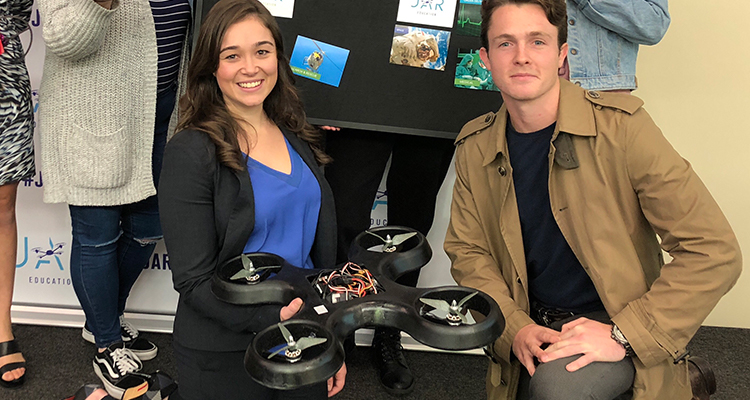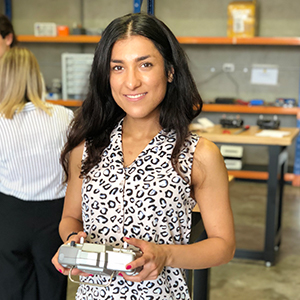
In preparation for a Grand Challenges discussion on August 2, Mahla Kafami, engineer and education project manager at JAR Aerospace, explains how drones can have a global impact.
Growing up, much like everyone else, I had a love for space. But it never went away. In fact, it was my main motivator for studying Engineering at UNSW – I saw it as my avenue to get into space. My first two years were hard, but as the program focused more on space engineering my passion reignited and I could clearly see my path. I applied to JAR Aerospace for an internship that would enable me to work in an industry that encouraged my love for space and technology. That passion just keeps growing and growing!
JAR Aerospace is only 18 months old. It was founded by four young entrepreneurs with a mission to go to space in five years. They soon realised that while technology is enhancing at a phenomenal rate, in Australia at least, the education system is not keeping up. The founders understand that to achieve their mission, they need to develop and engage the minds of the future. So they set up JAR Education to create change today, for the generation of tomorrow. This is where I work – it’s great to excite young minds and inspire those who have similar passions to me.
Our focus is on educating young Australians on drones. How they’re made; how they work; how they fly; and perhaps most importantly, how they can be used in everyday life.
Drones can, quite literally, do anything if they are certified to do so. Most of the things we want for this world can be made possible with the use of drones. From photography and videography; to 3D rendering of mines; to search and rescue in remote areas where sensors detect thermal heat and notify authorities; to delivering blood and organs from one hospital to another for donor transplants. I’ve even heard of an edible drone that can be sent to a disaster zone, where it lands and is eaten.
For me personally, this is where I think drones can be have the greatest impact. They can help us address the problems facing our global society, particularly in third world countries and disaster-relief zones such as post-hurricanes or storms where resources are scarce. A mother drone that houses lots of mini-drones can get to these places easily and safely. The mini-drones fly out, quickly disperse the much needed supplies, then fly back to the mother to recharge and repeat.

At JAR Aerospace, drones play a key role in fulfilling our mission to be in space in five years. The drone technology we develop and build today is used as the foundation for the technology that will be developed to go to space. We use drones to test how things fly, act and respond to different situations and challenges. I’ve always been concerned about the lack of regulation when it comes to keeping our earth and the space around it clean. At uni, I signed up to a course where we got to design our own satellite (on paper). I designed a debris-tracking satellite cube-set that could track all the debris surrounding our planet so we have a better understanding of the hazards. In space, if two objects collide, they shatter into a thousand pieces and send them ricocheting which could be highly dangerous. It would be great to test this idea using drones.
That’s what’s so great about today’s technology: anything is really possible, from the smallest ideas to the biggest. And Australia is the best country to build and develop drone technology and capabilities because the Civil Aviation Safety Authority (CASA) has such stringent regulations in place when it comes to drones - both in terms of flying and the technology itself. I also think we are a culture of people that respect these rules and standards. That’s why I believe Australia is going to rapidly grow to become one of the biggest competitors in space-related industries – especially now the Government is taking strong steps to develop the Aerospace technology and capabilities of Australia with the launch of the first Australian Space Agency.
A key part of enabling any of these possibilities is education. That’s where my focus lies. I’m working on a new drone for education and we have a new program in the works that will allow students to get even more hands on experience with drones. It’s so amazing to see a child so engaged with the drone technology we have today and so inspired about the potential applications for the future. I want to educate young Australians not just on the technology, but in our ability to achieve whatever we want. We just need to believe that we can. I certainly do.
Join Mahla and the other panellists at the UNSW Grand Challenges event, A bird’s eye view: Drones in Engineering, Art and Everyday Life on 2 August at 4pm in The Roundhouse. Click here for details and to register your attendance.
The UNSW Grand Challenges program addresses the biggest issues facing humanity today – and their potential solutions. The program is calling for expressions of interest for the fifth grand challenge: Rapid Urbanisation. If you are interested in applying, click here for more information or email grand.challenges@unsw.edu.au. Closing date for submissions is 27 July.
- Log in to post comments
